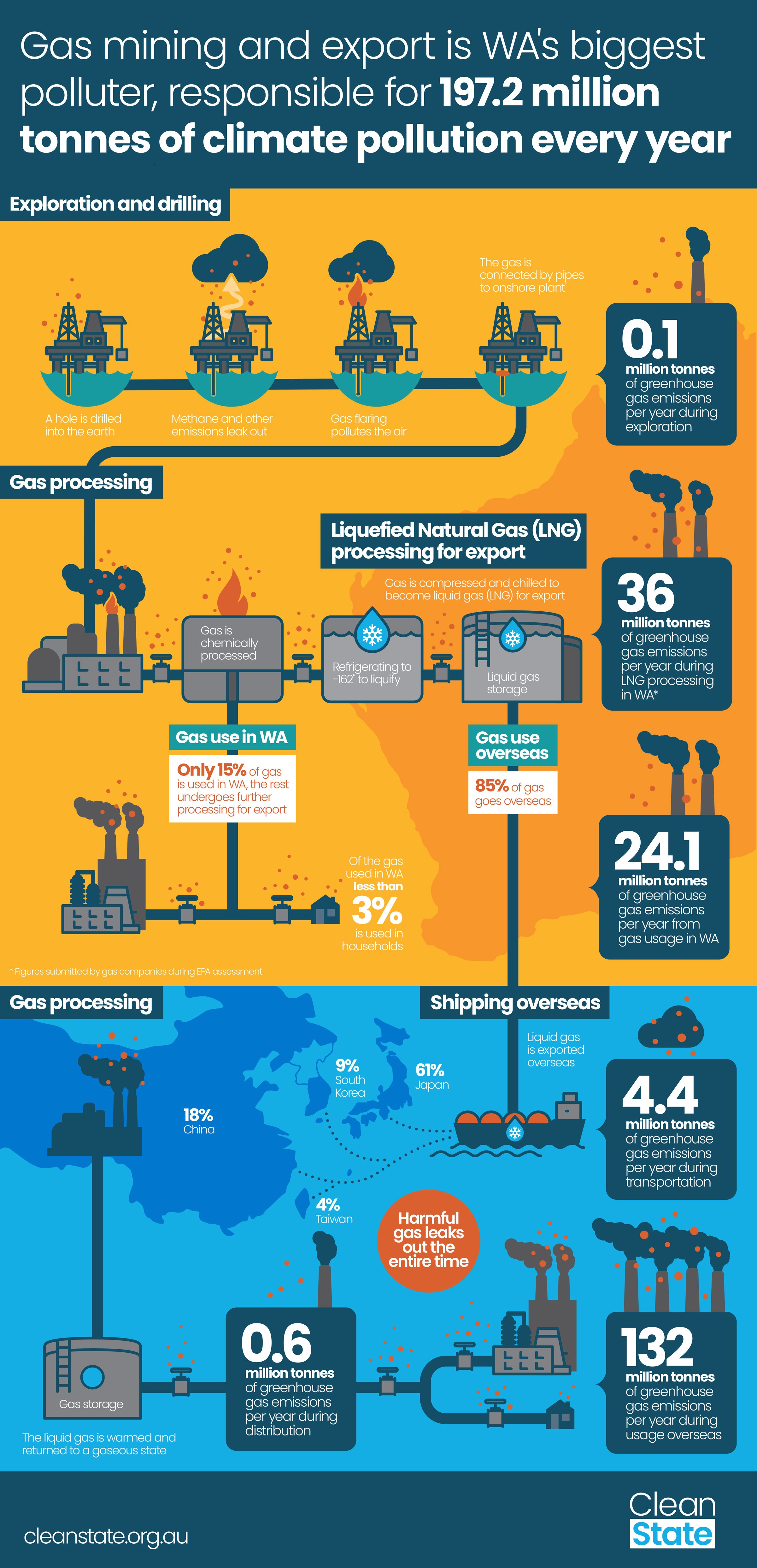By Chris Johansen, Green Issue Co-editor
are rising faster than in any other state, primarily due to the expansion of liquified natural gas (LNG) exports. WA has now surpassed Qatar as the jurisdiction with the largest export of LNG – i.e. world champions – something to be proud of?!? The extent of pollution from the WA LNG industry is depicted in the infographic below. Please note that of the total annual GHG emissions (197.2 million tonnes), only about one-third is accounted as WA emissions in the . The other two-thirds result from GHG emissions from use of the LNG in export destinations.

Even more amazing is that the multinational companies extracting, processing and exporting this natural gas , as these are based on ‘profits’ which those skilled in creative accounting can game. Essentially, we are giving away our resources for free to the world’s largest multinationals, with the exploitation of those resources significantly contributing to the climate crisis, while the government relies on taxes collected from ordinary people. Quite gob-smacking!
Particularly in view of the expanding LNG export industry, the WA Environmental Protection Authority (EPA) had been preparing guidelines specifically for addressing GHG pollution in WA. It of this year but after from the oil and gas industry, and criticism from the federal government, Labor premier Mark McGowan said he would not endorse the guidelines. The EPA immediately withdrew the guidelines but reopened an extended consultation period, to 2nd September 2019.
A major argument of the opposing multinationals, and of the Commonwealth Minister for Energy and Emissions Reduction, Angus Taylor, was that increasing export of LNG decreases global GHG emissions as LNG replaces coal which is more emissions intensive. Err … no, according to the , full life cycle emissions from current LNG export proposals exceed those from proposed new coal plants. Fugitive emissions and leakages in LNG extraction, processing and transport boost its full life cycle emissions to levels comparative with coal. If the Minister was really concerned about global GHG emissions, he would suggest that overseas coal burning convert to low emissions renewable energy, which in any case is now cheaper than importing LNG.
Another major concern of the LNG multinationals was the prospect of having to pay for GHG emission offsets for GHG emissions of an enterprise exceeding 100,000 tonnes of CO2 per annum. Indeed a technical requirement for establishment of the Gorgon Project was that they establish a carbon capture and storage facility, to pump CO2 underground, but they have . Offsets involve carbon capture in geological reservoirs or vegetation (e.g. reafforestation). Such extra costs would certainly tarnish the golden egg upon which they now sit.
The GHG guidelines would not only apply to existing and proposed gas extraction sites on the North-west Shelf but also to existing petroleum exploration areas on land, and mainly in the Kimberley. The state government lifted the fracking ban on these areas last November.
In reaction to this blatant display of corporate muscle, , a campaign under the auspices of the Conservation Council of WA (CCWA), organized a ‘WA Climate Pollution Forum’ on 18th June. Clean State aims to highlight the GHG pollution caused by LNG production in WA and propose solutions to it. Kate Kelly convened the Forum, which featured several prominent speakers ‒ WA Chief Scientist Prof. Peter Klinken, Dr Hugh Finn of Curtin University Law School, EPA Deputy Chair Robert Harvey, Tim Macknay, a solicitor with the (EDO), and Kent Broad, representing .
Presentations and subsequent Q&A highlighted that WA is now considered a global example of climate change underway – there has been a marked decrease in rainfall in southern WA over the previous half century, as the winter rain-bearing cold fronts track further south. In view of this ever-worsening consequence logic would suggest that WA would be particularly concerned about further exacerbating climate change through increased GHG emissions. However, on the contrary it seems, WA’s GHG emissions were up some 23% from 2005 levels, with prospects of increasing rates of emissions as more offshore gas wells come online and the state moratorium on fracking is lifted. In that period, emissions in the other states were trending downwards as renewable energy is being increasingly deployed and some coal-fired power stations closed down. Further, all states and territories, except WA and the Northern Territory, have legislation or policy targeting zero net emissions by 2050.
During the course of this forum, it was clarified that the basic role of the WA EPA is to use its best endeavours to protect the environment and prevent, control and abate pollution and environmental harm. However, it is merely an advisory body to the state government and has no direct regulatory powers. It sets the parameters for legislation for the state government to implement and be responsible for enforcing. The EPA approaches GHG mitigation as three-fold: avoiding them in the first place (e.g. low emissions energy, energy efficiency); reducing them over time (e.g. reduce leaks, phase in energy efficient equipment); and offsetting them (e.g. revegetation).
Due to the intense, and so far effective, lobbying by the fossil fuel industry, it is essential that this be countered by those concerned about climate change in this extended period of EPA consultation on development of guidelines on GHG emissions. As many Greens members as possible need to step up to the plate here. So, if you read this article before 2nd September 2019, please consider making a submission. The EPA’s Consultation Hub is , on which can be found their and site from which a








